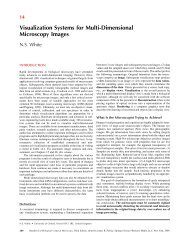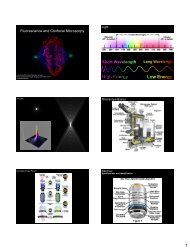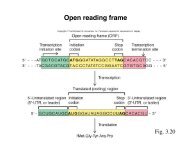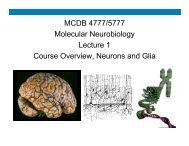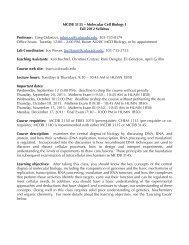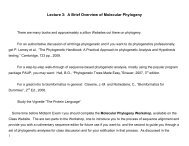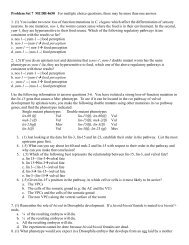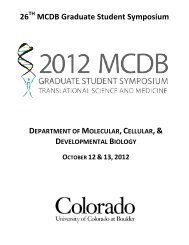Wnt Signaling Polarizes an Early C. elegans ... - MCD Biology
Wnt Signaling Polarizes an Early C. elegans ... - MCD Biology
Wnt Signaling Polarizes an Early C. elegans ... - MCD Biology
Create successful ePaper yourself
Turn your PDF publications into a flip-book with our unique Google optimized e-Paper software.
Cell Polarity <strong>an</strong>d Endoderm Specification<br />
705<br />
Avery, L., <strong>an</strong>d Horvitz, H.R. (1989). Pharyngeal pumping continues required to distinguish the fates of equivalent blastomeres in early<br />
after laser killing of the pharyngeal nervous system of C. eleg<strong>an</strong>s. C. eleg<strong>an</strong>s embryos. Development 120, 2305–2315.<br />
Neuron 3, 473–485. Mello, C.C., Kramer, J.M., Stinchcomb, D., <strong>an</strong>d Ambros, V. (1991).<br />
Behrens, J., von Kries, J.P., Kuhl, M., Bruhn, L., Wedlich, D., Efficient gene tr<strong>an</strong>sfer in C. eleg<strong>an</strong>s: extrachromosomal mainte-<br />
Grosschedl, R., <strong>an</strong>d Birchmeier, W. (1996). Functional interaction of n<strong>an</strong>ce <strong>an</strong>d integration of tr<strong>an</strong>sforming sequences. EMBO J. 10,<br />
-catenin with the tr<strong>an</strong>scription factor LEF-1. Nature 382, 638–642. 3959–3970.<br />
Bowerm<strong>an</strong>, B., Eaton, B.A., <strong>an</strong>d Priess, J.R. (1992). skn-1, a mater- Mello, C.C., Draper, B.W., Krause, M., Weintraub, H., <strong>an</strong>d Priess,<br />
nally expressed gene required to specify the fate of ventral blasto- J.R. (1992). The pie-1 <strong>an</strong>d mex-1 genes <strong>an</strong>d maternal control of<br />
meres in the early C. eleg<strong>an</strong>s embryo. Cell 68, 1061–1075. blastomere identity in early C. eleg<strong>an</strong>s embryos. Cell 70, 163–176.<br />
Brenner, S. (1974). The genetics of Caenorhabditis eleg<strong>an</strong>s. Genet- Mello, C.C., Draper, B.W., <strong>an</strong>d Priess, J.R. (1994). The maternal<br />
ics 77, 71–94. genes apx-1 <strong>an</strong>d glp-1 <strong>an</strong>d establishment of dorsal–ventral polarity<br />
Brunner, E., Peter, O., Schweizer, L., <strong>an</strong>d Basler, K. (1997). p<strong>an</strong>golin in the early C. eleg<strong>an</strong>s embryo. Cell 77, 95–106.<br />
encodes a Lef-1 homologue that acts downstream of armadillo to Merriam, J.M., Rubinstein, A.B., <strong>an</strong>d Klymkowsky, M.W. (1997). Cytr<strong>an</strong>sduce<br />
the wingless signal in Drosophila. Nature 385, 829–833. toplasmically <strong>an</strong>chored plakoglobin induces a WNT-like phenotype<br />
Draper, B.W., Mello, C.C., Bowerm<strong>an</strong>, B., Hardin, J., <strong>an</strong>d Priess, J.R. in Xenopus embryos. Dev. Biol. 185, 67–81.<br />
(1996). MEX-3 is a KH domain protein that regulates blastomere Miller, J.M., <strong>an</strong>d Moon, R.T. (1996). Signal tr<strong>an</strong>sduction through<br />
identity in early C. eleg<strong>an</strong>s embryos. Cell 87, 205–216. -catenin <strong>an</strong>d specification of cell fate during embryogenesis.<br />
Du, S.J., Purcell, S.M., Christi<strong>an</strong>, J.L., McGrew, L.L., <strong>an</strong>d Moon, R.T. Genes Dev. 10, 2527–2539.<br />
(1995). Identification of distinct classes <strong>an</strong>d functional domains of Miller, D.M.I., Ortiz, I., Berliner, G.C., <strong>an</strong>d Epstein, H.F. (1983). Differ-<br />
<strong>Wnt</strong>s through expression of wild-type <strong>an</strong>d chimeric proteins in Xeno- ential localization of two myosins within nematode thick filaments.<br />
pus embryos. Mol. Cell. Biol. 15, 2625–2634. Cell 34, 477–790.<br />
Edgar, L. (1995). Blastomere culture <strong>an</strong>d <strong>an</strong>alysis. In Caenorhabditis Nusse, R., <strong>an</strong>d Varmus, H.E. (1992). <strong>Wnt</strong> genes. Cell 69, 1073–1087.<br />
eleg<strong>an</strong>s: Modern Biological Analysis of <strong>an</strong> Org<strong>an</strong>ism. (S<strong>an</strong> Diego,<br />
CA: Academic Press), pp. 303–321.<br />
Goldstein, B. (1992). Induction of gut in Caenorhabditis eleg<strong>an</strong>s<br />
embryos. Nature 357, 255–257.<br />
Goldstein, B. (1993). Establishment of gut fate in the E lineage of<br />
C. eleg<strong>an</strong>s: the roles of lineage-dependent mech<strong>an</strong>isms <strong>an</strong>d cell<br />
interactions. Development 118, 1267–1277.<br />
Goldstein, B. (1995a). An <strong>an</strong>alysis of the response to gut induction<br />
in the C. eleg<strong>an</strong>s embryo. Development 121, 1227–1236.<br />
Parr, B.A., <strong>an</strong>d McMahon, A.P. (1994). <strong>Wnt</strong> genes <strong>an</strong>d vertebrate<br />
development. Curr. Opin. Genet. Dev. 4, 523–528.<br />
Priess, J.R., Schnabel, H. <strong>an</strong>d Schnabel, R. (1987). The glp-1 locus<br />
<strong>an</strong>d cellular interactions in early C. eleg<strong>an</strong>s embryos. Cell 51,<br />
601–611.<br />
Pruss, R.M., Mirsky, R., Raff, M.C., Thorpe, R., Dowding, A.J., <strong>an</strong>d<br />
Anderton, B.H. (1981). All classes of intermediate filaments share a<br />
common <strong>an</strong>tigenic determin<strong>an</strong>t defined by a monoclonal <strong>an</strong>tibody.<br />
Cell 27, 419–428.<br />
Goldstein, B. (1995b). Cell contacts orient some cell division axes<br />
in the Caenorhabditis eleg<strong>an</strong>s embryo. J. Cell Biol. 129, 1071–1080.<br />
Riese, J., Yu, X., Munnerlyn, A., Eresh, S., Hsu, S.C., Grosschedl, R.,<br />
<strong>an</strong>d Bienz, M. (1997). LEF-1, a nuclear factor coordinating signaling<br />
Gonczy, P., <strong>an</strong>d Hym<strong>an</strong>, A.A. (1996). Cortical domains <strong>an</strong>d the mech- inputs from wingless <strong>an</strong>d decapentaplegic. Cell 88, 777–787.<br />
<strong>an</strong>isms of asymmetric cell division. Trends Cell Biol. 6, 382–387.<br />
Schierenberg, E. (1987). Reversal of cellular polarity <strong>an</strong>d early cell–<br />
Herm<strong>an</strong>, M.A., <strong>an</strong>d Horvitz, H.R. (1994). The Caenorhabditis eleg<strong>an</strong>s cell interactions in the embryo of Caenorhabiditis eleg<strong>an</strong>s. Dev. Biol.<br />
gene lin-44 controls the polarity of asymmetric cell divisions. Devel- 122, 452–463.<br />
opment 120, 1035–1047.<br />
Shelton, C.A., <strong>an</strong>d Bowerm<strong>an</strong>, B. (1996). Time-dependent responses<br />
Herm<strong>an</strong>, M.A., Vassilieva, L.L., Horvitz, H.R., Shaw, J.E., <strong>an</strong>d Her- to glp-1-mediated inductions in early C. eleg<strong>an</strong>s embryos. Developm<strong>an</strong>,<br />
R.K. (1995). The C. eleg<strong>an</strong>s gene lin-44, which controls the ment 122, 2043–2050.<br />
polarity of certain asymmetric divisions, encodes a <strong>Wnt</strong> protein <strong>an</strong>d<br />
acts cell nonautonomously. Cell 83, 101–110.<br />
Hird, S.N., Paulsen, J.E., <strong>an</strong>d Strome, S. (1996). Segregation of germ<br />
gr<strong>an</strong>ules in living Caenorhabditis eleg<strong>an</strong>s embryos: cell-type-specific<br />
mech<strong>an</strong>isms for cytoplasmic localization. Development 122,<br />
1303–1312.<br />
Horvitz, H.R., <strong>an</strong>d Herskowitz, I. (1992). Mech<strong>an</strong>isms of asymmetric<br />
cell division: two Bs or not two Bs, that is the question. Cell 68,<br />
237–255.<br />
Hutter, H., <strong>an</strong>d Schnabel, R. (1994). glp-1<strong>an</strong>d inductions establishing<br />
embryonic axes in C. eleg<strong>an</strong>s. Development 120, 2051–2064.<br />
Hym<strong>an</strong>, A.A., <strong>an</strong>d White, J.G. (1987). Determination of cell division<br />
axes in the early embryogenesis of Caenorhabditis eleg<strong>an</strong>s. J. Cell<br />
Biol. 105, 2123–2135.<br />
Strome, S., <strong>an</strong>d Wood, W.B. (1983). Generation of asymmetry <strong>an</strong>d<br />
segregation of germ-line gr<strong>an</strong>ules in early C. eleg<strong>an</strong>s embryos. Cell<br />
35, 15–25.<br />
Sulston, J.E., Schierenberg, E., White, J.G., <strong>an</strong>d Thomson, J.N.<br />
(1983). The embryonic cell lineage of the nematode Caenorhabditis<br />
eleg<strong>an</strong>s. Developmental <strong>Biology</strong> 100, 64–119.<br />
v<strong>an</strong> den Heuvel, M., Harrym<strong>an</strong>-Samos, C., Klingensmith, J., Perri-<br />
mon, N., <strong>an</strong>d Nusse, R. (1993). Mutations in the segment polarity<br />
genes wingless <strong>an</strong>d porcupine impair secretion of the wingless protein.<br />
EMBO J. 12, 5293–5302.<br />
v<strong>an</strong> de Wetering, M., Cavallo, R., Dooijes, D., v<strong>an</strong> Beest, M., v<strong>an</strong> Es,<br />
J., Loureiro, J., Ypma, A., Hursh, D., Jones, T., Bejsovec, A., et al.<br />
(1997). Armadillo coactivates tr<strong>an</strong>scription driven by the product of<br />
the Drosophila segment polarity gene dTCF. Cell 88, 789–799.<br />
Kadowaki, T., Wilder, E., Klingensmith, J., Zachary, K.,<strong>an</strong>d Perrimon,<br />
N. (1996). The segment polarity gene porcupine encodes a putative<br />
multitr<strong>an</strong>smembr<strong>an</strong>e protein involved in Wingless processing.<br />
Genes Dev. 10, 3116–3128.<br />
Kemphues, K.J., Priess, J.R., Morton, D.G., <strong>an</strong>d Cheng, N.S. (1988).<br />
Identification of genes required for cytoplasmic localization in early<br />
C. eleg<strong>an</strong>s embryos. Cell 52, 311–320.<br />
Lin, R., Thompson, S., <strong>an</strong>d Priess, J.R. (1995). pop-1 encodes <strong>an</strong><br />
HMG box protein required for the specification of a mesoderm precursor<br />
in early C. eleg<strong>an</strong>s embryos. Cell 83, 599–609.<br />
M<strong>an</strong>go, S.E., Lambie, E.J., <strong>an</strong>d Kimble, J. (1994a). The pha-4 gene<br />
is required to generate thepharyngeal primordium of Caenorhabditis<br />
eleg<strong>an</strong>s. Development 120, 3019–3031.<br />
M<strong>an</strong>go, S.E., Thorpe, C.J., Martin, P.R., Chamberlain, S.H., <strong>an</strong>d<br />
Bowerm<strong>an</strong>, B. (1994b). Two maternal genes, apx-1 <strong>an</strong>d pie-1, are<br />
Yochem, J., <strong>an</strong>d Greenwald, I. (1989). glp-1 <strong>an</strong>d lin-12, genes implicated<br />
in distinct cell–cell interactions in C. eleg<strong>an</strong>s, encode similar<br />
tr<strong>an</strong>smembr<strong>an</strong>e proteins. Cell 58, 553–563.




